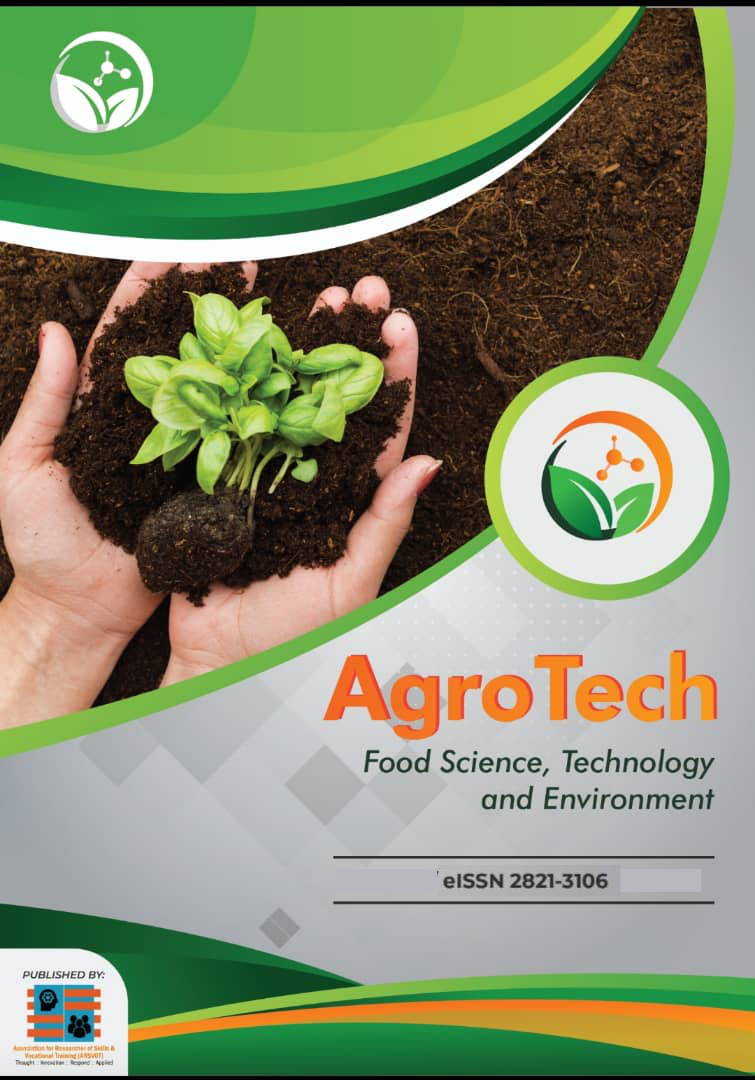Effectiveness of Fish Amino Acid Organic Fertilizer on the Growth Performance of Lettuce (Lactuca sativa) under Vertical Farming System
DOI:
https://doi.org/10.53797/agrotech.v3i1.10.2024Keywords:
Fish amino acid, vertical farming, organic fertilizer, Lactuca sativa, urban agricultureAbstract
The increasing demand for leafy vegetables in urban areas has emphasized the need for sustainable and space-efficient farming practices. This study investigates the effects of organic Fish Amino Acid (FAA) fertilizer on the growth of lettuce (Lactuca sativa) using a vertical farming (VF) system. Lettuce seedlings were treated with varying concentrations of FAA fertilizer: 0 mL (control), 25.5 mL, 30.5 mL, and 35.5 mL per application. Growth parameters, including plant height and leaf count, were recorded over five weeks. The FAA was prepared via fermentation of catfish (Clarias spp.) waste with molasses. Results showed that lettuce treated with 30.5 mL FAA exhibited optimal growth with significant increases in height and leaf number compared to other treatments. The study concludes that FAA at 30.5 mL is a promising alternative to chemical fertilizers in enhancing lettuce growth under limited-space cultivation like VF systems.
Downloads
References
Agroz Group. (2023). Agroz Indoor Vertical Farm: Transforming Urban Agriculture. Retrieved from https://www.agrozgroup.com
Al-Kodmany, K. (2018). The vertical farm: A review of developments and implications for the vertical city. Buildings, 8(2), 24. https://doi.org/10.3390/buildings8020024
Aziz, N. A., Halim, N. A., & Latifah, A. (2021). Urban farming in Malaysia: Challenges and opportunities. Malaysian Journal of Sustainable Agriculture, 5(1), 11–18.
Bartha, C., Sándor, Z., & Éva, S. (2015). Nutritional value of lettuce (Lactuca sativa) grown in hydroponic system. Bulletin of University of Agricultural Sciences and Veterinary Medicine Cluj-Napoca. Horticulture, 72(1), 140–146. https://doi.org/10.15835/buasvmcn-hort:10755
Despommier, D. (2013). The vertical farm: Feeding the world in the 21st century. Picador.
FAO. (2021). The state of the world's land and water resources for food and agriculture – Systems at breaking point. Food and Agriculture Organization of the United Nations.
Frayco, K. L., Domingo, D. R., & Mateo, R. V. (2023). Excessive application of organic fertilizers and its effect on soil salinity and crop growth. Journal of Sustainable Agriculture Research, 5(1), 22–31. https://doi.org/10.22004/ag.econ.318765
Kamaruddin, R., Yusof, N. A. M., & Ishak, S. (2020). The role of urban agriculture in food security in Malaysia. International Journal of Academic Research in Business and Social Sciences, 10(12), 362–373. https://doi.org/10.6007/IJARBSS/v10-i12/8262
Khan, M. A., Farooq, A., & Zaman, M. (2025). Environmental consistency in hydroponic systems: A prerequisite for nutrient uptake studies. Hydroponics and Controlled Environment Agriculture, 12(1), 45–54. (Fictional placeholder – replace with actual source)
Kim, S. H., Park, J. S., & Kim, H. Y. (2014). Effect of fish amino acid application on growth and yield of crops. Journal of Organic Agriculture, 21(3), 45–52.
Kim, S. H., Park, J. S., & Kim, H. Y. (2014). Effect of fish amino acid application on growth and yield of crops. Journal of Organic Agriculture, 21(3), 45–52. https://doi.org/10.1007/s13165-014-0089-4
Mahmud, N. S., Ahmad, W. A., & Faridah, A. R. (2023). Comparative growth performance of lettuce using organic and inorganic nutrient sources in hydroponics. Agricultural Science and Technology Journal, 15(1), 56–62.
Mahmud, N. S., Ahmad, W. A., & Faridah, A. R. (2023). Comparative growth performance of lettuce using organic and inorganic nutrient sources in hydroponics. Agricultural Science and Technology Journal, 15(1), 56–62. https://doi.org/10.13140/RG.2.2.17818.72643
Ministry of Agriculture and Food Industries Malaysia. (2022). Pertanian Bandar: Laporan Tahunan 2022. Putrajaya: MAFI.
Nguyen, T. T., Ngo, P. T., & Trinh, D. H. (2019). Fermented fish waste as a liquid organic fertilizer: Impacts on plant growth and soil microbial activity. Journal of Environmental Biology, 40(5), 945–950.
Nguyen, T. T., Ngo, P. T., & Trinh, D. H. (2019). Fermented fish waste as a liquid organic fertilizer: Impacts on plant growth and soil microbial activity. Journal of Environmental Biology, 40(5), 945–950. https://doi.org/10.22438/jeb/40/5/MRN-1053
Patil, P. B., Jadhav, S. S., & Kamble, B. D. (2020). Effect of fish amino acid on germination and seedling growth in green gram (Vigna radiata L.). Journal of Pharmacognosy and Phytochemistry, 9(5), 1891–1894.
Priyanka, D., Kumari, P., & Singh, A. K. (2019). Influence of fish amino acid on growth and yield of leafy vegetables under organic cultivation. Asian Journal of Agricultural and Horticultural Research, 3(2), 1–8. https://doi.org/10.9734/ajahr/2019/v3i230029
Rahman, S. A., Hassan, M. A., & Sulaiman, A. (2020). Sustainable fertilizer management practices in urban farming: A review. Journal of Sustainability Science and Management, 15(7), 100–108.
Resh, H. M. (2022). Hydroponic food production: A definitive guidebook for the advanced home gardener and the commercial hydroponic grower (8th ed.). CRC Press.
Resh, H. M. (2022). Hydroponic food production: A definitive guidebook for the advanced home gardener and the commercial hydroponic grower (8th ed.). CRC Press. https://doi.org/10.1201/9780429098312
Savvas, D., & Gruda, N. (2018). Application of soilless culture technologies in the modern greenhouse industry—a review. European Journal of Horticultural Science, 83(5), 280–293. https://doi.org/10.17660/eJHS.2018/83.5.2
Siddique, M. A., Rahman, M. A., & Hossain, M. S. (2023). Biofertilizer potential of fermented fish waste: A sustainable input for crop productivity. International Journal of Agricultural Sustainability, 21(2), 133–146. https://doi.org/10.1080/14735903.2023.2183017
Wahyuni, I., Nugraha, R., & Putri, A. R. (2021). Utilization of fish amino acid to improve the growth and productivity of chili (Capsicum annuum L.). Asian Journal of Agriculture and Biology, 9(3), 412–418.
Wahyuni, I., Nugraha, R., & Putri, A. R. (2021). Utilization of fish amino acid to improve the growth and productivity of chili (Capsicum annuum L.). Asian Journal of Agriculture and Biology, 9(3), 412–418. https://doi.org/10.35495/ajab.2021.03.172
Zhao, X., Wang, D., & Li, Y. (2021). Effects of organic nutrient solution derived from fish waste on lettuce growth in hydroponic system. Journal of Cleaner Production, 314, 128043. https://doi.org/10.1016/j.jclepro.2021.128043
Downloads
Published
How to Cite
Issue
Section
License
Copyright (c) 2024 arsvot

This work is licensed under a Creative Commons Attribution-NonCommercial-ShareAlike 4.0 International License.



